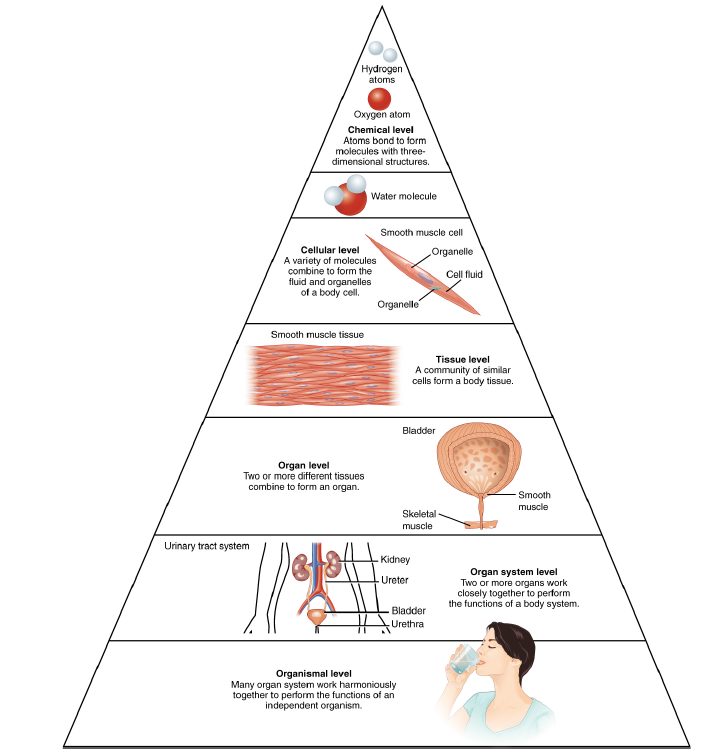Objective:
- Describe the structure of the body, from simplest to most complex, in terms of the six levels of organization.
Hierarchical Levels of the Organization of Life
Before you begin to study the different structures and functions of the human body, it is helpful to consider its basic architecture; that is, how its smallest parts are assembled into larger structures. It is convenient to consider the structures of the body in terms of fundamental levels of organization that increase in complexity: subatomic particles, atoms, molecules, organelles, cells, tissues, organs, organ systems, organisms and biosphere (Figure 1).

Figure 1. Levels of Structural Organization of the Human Body. The organization of the body often is discussed in terms of six distinct levels of increasing complexity, from the smallest chemical building blocks to a unique human organism.
CC BY: OpenStax College
Knowledge of the different levels of organization of the human body will help you understand the basic concepts of physiology. Most problems of the body are cellular problems, so pay attention to the cellular and chemical topics you learn here and you can build on those to understand the body as a whole. To study the chemical level of organization, scientists consider the simplest building blocks of matter: subatomic particles, atoms and molecules. All matter in the universe is composed of one or more unique pure substances called elements, familiar examples of which are hydrogen, oxygen, carbon, nitrogen, calcium, and iron. The smallest unit of any of these pure substances (elements) is an atom. Atoms are made up of subatomic particles such as the proton, electron and neutron. Two or more atoms combine to form a molecule, such as the water molecules, proteins, and sugars found in living things. Molecules are the chemical building blocks of all body structures.
Molecules make up microscopic parts of our cells called organelles, which work together, much as a factory would run efficiently, for the best output. A cell is the smallest independently functioning unit of a living organism and is surrounded by a flexible, screen-like membrane. Even bacteria, which are extremely small, independently-living organisms, have a cellular structure. Each bacterium is a single cell. All living structures of human anatomy contain cells, and almost all functions of human physiology are performed in cells or are initiated by cells. In humans, as in all organisms, cells perform all functions of life. A tissue is a group of many similar cells (though sometimes composed of a few related types) that work together to perform a specific function. An organ is an anatomically distinct structure of the body composed of two or more tissue types. Each organ performs one or more specific physiological functions. An organ system is a group of organs that work together to perform major functions or meet physiological needs of the body. We will discuss 11 distinct organ systems of the body. The organism level is the highest level of organization. An organism is a living being that has a cellular structure and that can independently perform all physiologic functions necessary for life. In multicellular organisms, including humans, all cells, tissues, organs, and organ systems of the body work together to maintain the life and health of the organism. This course does not cover much about relationships between organisms, but all earthly levels of organization of life are briefly detailed below for your information.
|
Atom |
The smallest unit of matter |
|
Molecule |
A cluster of atoms bonded together |
|
Organelle |
A membrane-enclosed portion of the cell performing a specific function |
|
Cell |
The smallest independently functioning unit of a living organism and is surrounded by a flexible, screen-like membrane |
|
Tissue |
A group of similar cells working on a common function |
|
Organ |
A group of tissues joined in a structural unit to serve a common function |
|
Organ System |
Several organs working together to perform a function |
|
Organism |
A living being that has a cellular structure and can independently perform all physiologic functions necessary for life. |
|
Population |
All the organisms of the same species |
|
Community |
All the living things in an areas |
|
Ecosystem |
All the living and nonliving things in an area |
|
Biosphere |
All of the environments on Earth that support life |
The following animation relates in detail the hierarchical organization of life.
Animation 1. View the Organization of Life animation on YouTube (opens in new window).
Activity not available on mobile devices (description)
Activity not available on mobile devices (description)
Directions: Click to download the Levels of Organizing Life PDF file (opens in new window). Fill in the Levels of Organizing Life (in ascending order) and add to you notebook.